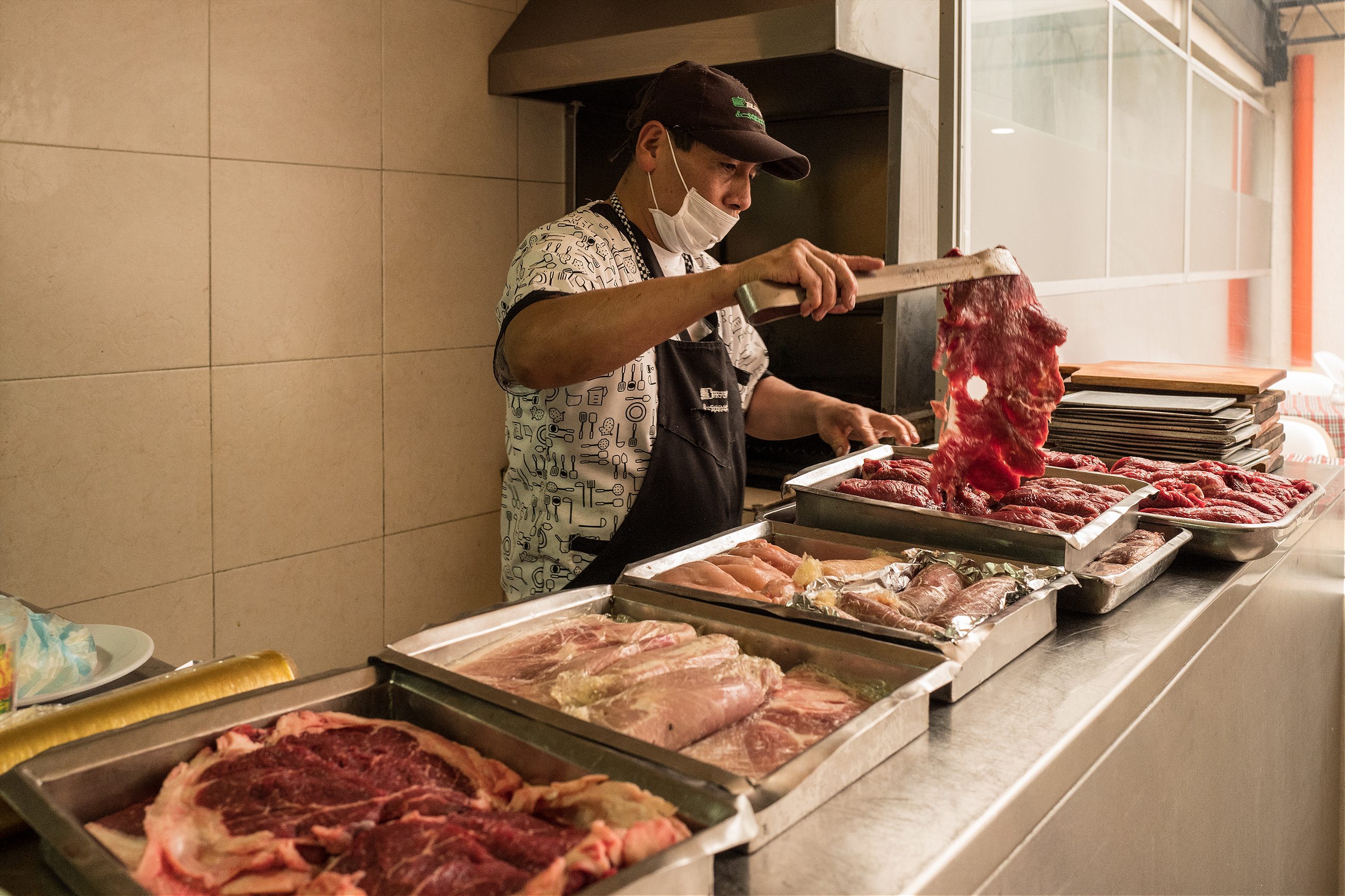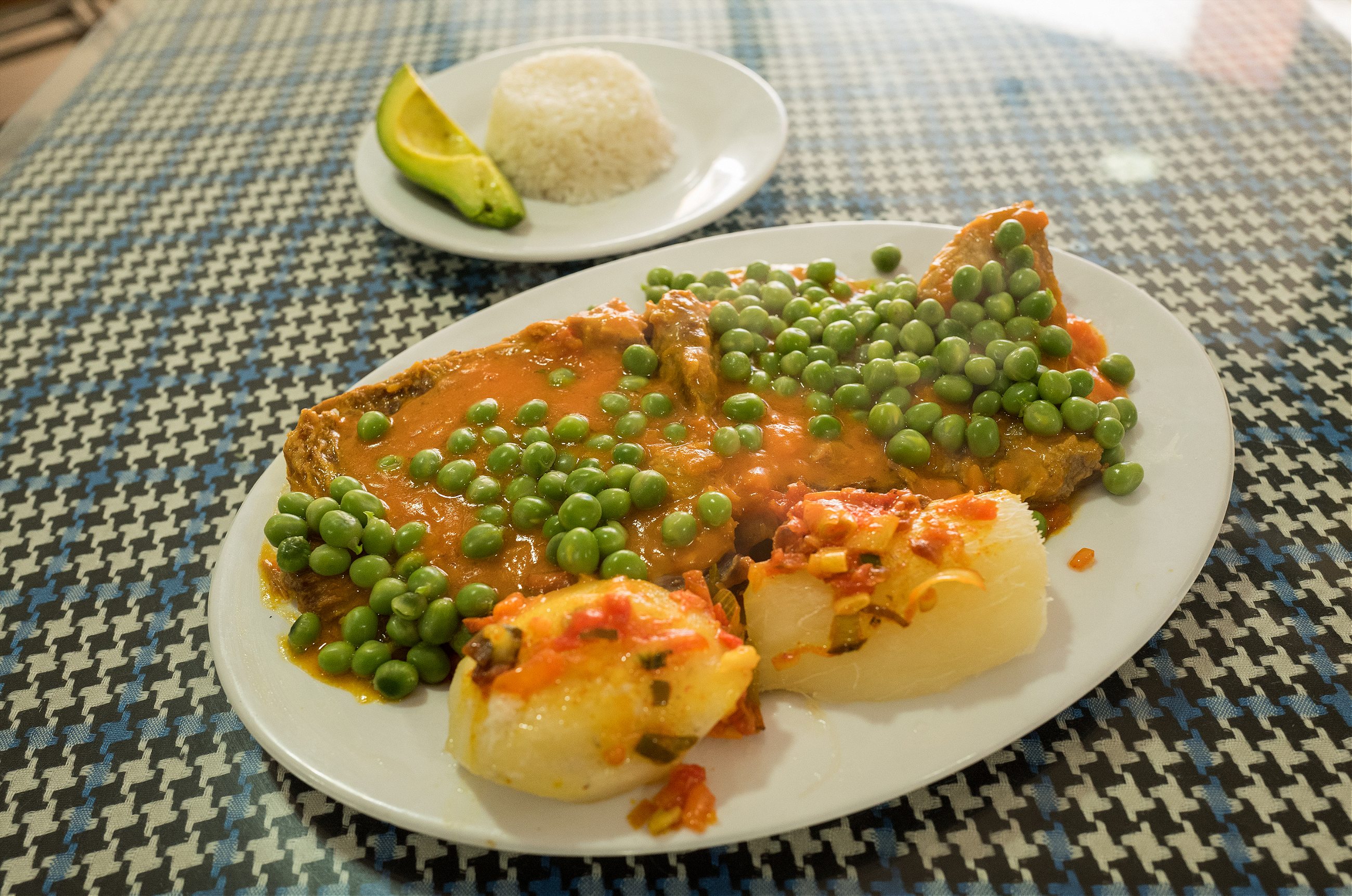Professional cook Miguel Olaya on his favorite cut of meat in Bogotá.
There are two things people say about traditional Colombian cuisine. The first is that there are only two dishes worth mentioning: Bogotá’s ajiaco (the potato-based stew synonymous with the capital), and bandeja paisa (“the Paisa tray”—Paisa being the name for things or people from Medellín and the Antioquia region), a rich meal made of a generous amount and variety of food, including meat, rice, eggs, plantains, and beans, served on a platter or tray. The signature dishes of Colombia’s two largest cities have overshadowed a culinary diversity present in history books, but not faithfully represented on the country’s menus, particularly in Bogotá. Go to any restaurant in the capital and, most likely, they will serve ajiaco and a bandeja paisa.
The second thing people say is that much Colombian food is an array of side dishes, not full meals—and side dishes not for the faint of heart (quite literally): empanadas, arepas, pandebonos, pandeyucas, and other members of the extended dough and pastry family, often fried; and not forgetting that deep-fried delight, chicharrón—pork skin.
Sadly, both claims contain a grain of truth. We do like our deep-fried snacks. And it’s not an exaggeration to say that most of the almost 600 dishes listed in “El Gran libro de la cocina colombiana” (“The Great Book of Colombian Cuisine,” an ethnographic project conducted in the early 1980s) are very hard, or even impossible, to find these days.
Lunch served in most cheap restaurants consists of some sort of soup, and a bandeja—the tray—with meat, usually grilled, and the requisite bunch of carbohydrates (rice, potatoes, yucca, noodles, and legumes are the most common) and, if you’re lucky, some form of salad.
But just because you can get this meal everywhere doesn’t mean you should get it just anywhere. There is a street in downtown Bogotá lined with sporting goods and clothing stores, with a lone restaurant among them, called Brasas y Sopas (“Embers/hot coals and soups”) which serves, for my money, the most delicious bandeja dish in Bogotá: sobrebarriga.
The sobrebarriga is a somewhat neglected staple of Bogotá cuisine: a flank steak—a challenging cut—and the carby side dishes that come with it. The meat is the muscle that surrounds the cow’s guts; sobrebarriga means “over the belly.” It’s a thick blanket of flesh with diverse textures, that tends to be thicker nearer the ribs and the diaphragm. The thin end is more gelatinous, and the thicker part has a firmer texture, but also has abundant peripheral fat, which is key for the cooking process. (Which end you’ll be served is a matter of luck.)

Because it’s not a naturally tender cut, the best way to cook it is to boil it. But there is a tool—a cornerstone of Colombian cuisine—that can step up the sobrebarriga game a notch or two. I am talking, of course, about the pressure cooker, that fearsome cauldron known locally as the “whistler”, the “express,” or the “atomic.”
A long time before serving, the meat is “whistled” several times to perfection. That means it’s subjected to otherworldly pressure and to temperatures well above that of boiling water. This breaks and softens the fibrous tissues, dissolving the collagen, giving it an improbably creamy texture for what started as a hunk of tough meat. The meat is left in the pot and covered until it cools down completely, so that the residual temperature continues to work its miraculous tenderizing effects.
When the sobrebarriga leaves the pot, it’s up to the restaurant guests to decide what happens to it next: to serve it en salsa (with sauce) or al horno (broiled). It should always be broiled: that’s how the fat melts completely, browning the surface, creating more flavor and contrast between the crust and the now-tender meat—a mark of quality for any roast.
Brasas y Sopas’ sobrebarriga tastes most like the one my late mother—my first cooking influence—used to make. Following a family recipe, she would marinate the meat with cheap beer, salt, thyme, and fresh bay leaves. I can’t guarantee that you’ll find this particular seasoning at Sopa y Brasas, but you’ll certainly find the most important things there: time, care, and generosity. A sobrebarriga evening at home came with 12 hours of anticipation.
I’ve tried to replicate mom’s sobrebarriga at home. As a professional cook, I’ve tried using the pressure cooker method, braising it, sous vide-ing it, making it into a roulade. Not bad, but never quite as good as Brasas y Sopas’.

Sobrebarriga is never served alone. The dish would be incomplete without rice, sweet ripe plantain, avocado salad, and potatoes. The white rice, cooked with only salt and oil, is the fundamental side dish of Colombian restaurants. The plantain is fried but it’s so ripe, sweet, and smooth that it has the texture of jam. The avocado is stirred with onions and chopped tomatoes, like a guacamole salad. And you can also ask for ají—hot sauce. (Colombian cuisine is not spicy, but hot sauce is always an option.) Potatoes, cooked in broth, are then bathed in a sauce of sautéd scallions, tomato, and sometimes cheese—a classic preparation and common accompaniment known as guiso, hogao, or ahogado. (The sauce can be ordered separately so you can drown the sobrebarriga in it. And you should.)
The sounds in Brasas y Sopas’ restaurant are like that in many other Colombian restaurants: the din of cutlery on plates, a TV set to the evening news or a soap opera. At some point, there might be a live guitar performance, musicians strumming and singing yearning ballads from years past. But this evocative scene won’t match the satisfaction of tasting—and finishing—what might be the whole sobrebarriga of a single cow. So, one final piece of advice: never order Brasas y Sopas’ sobrebarriga on your own.